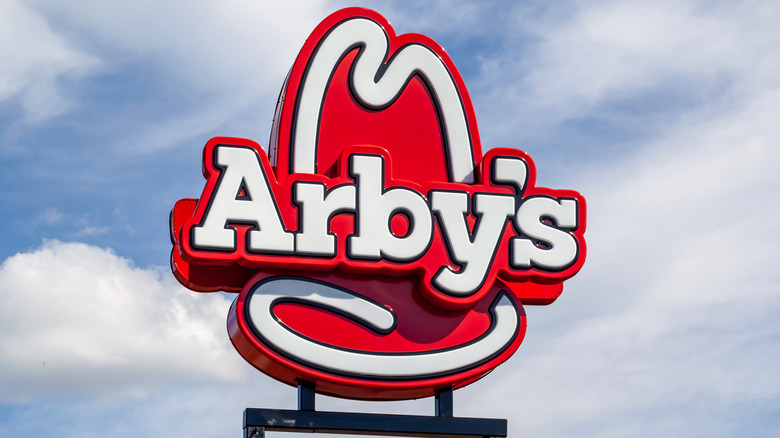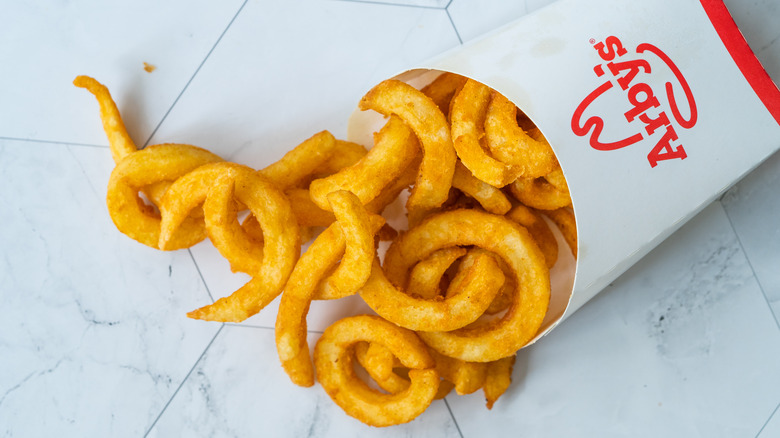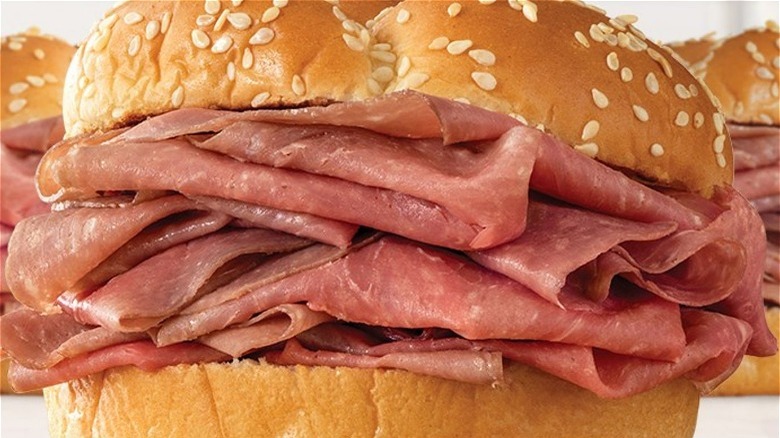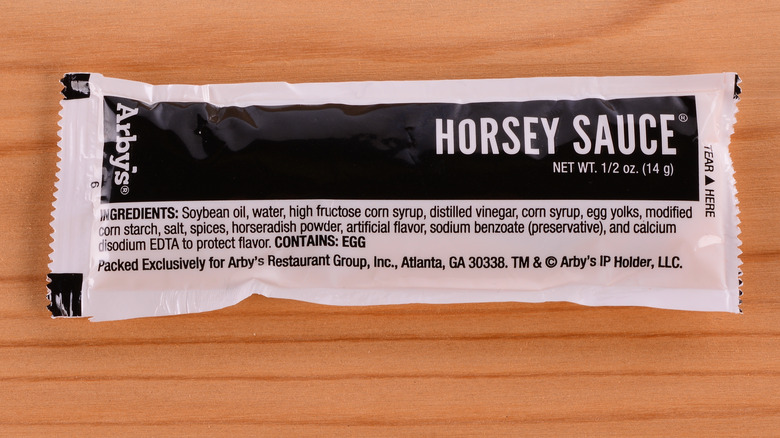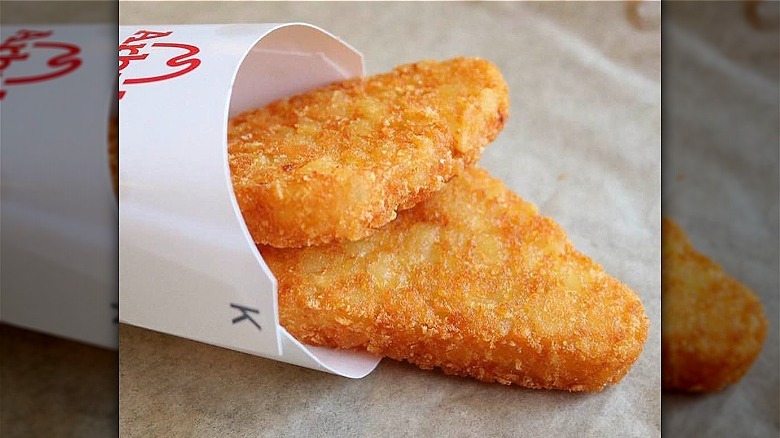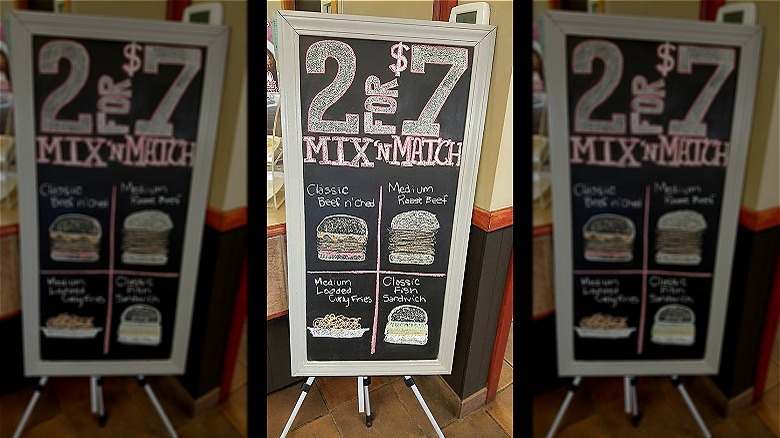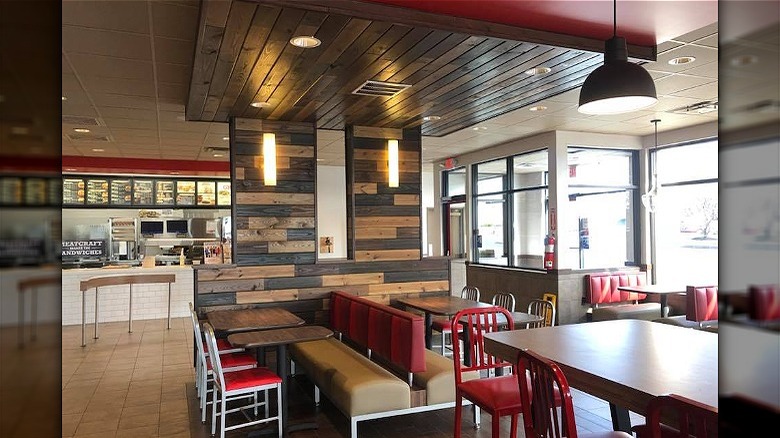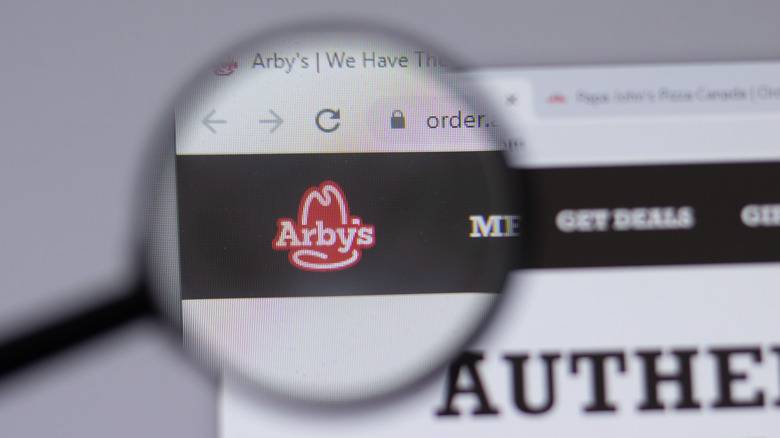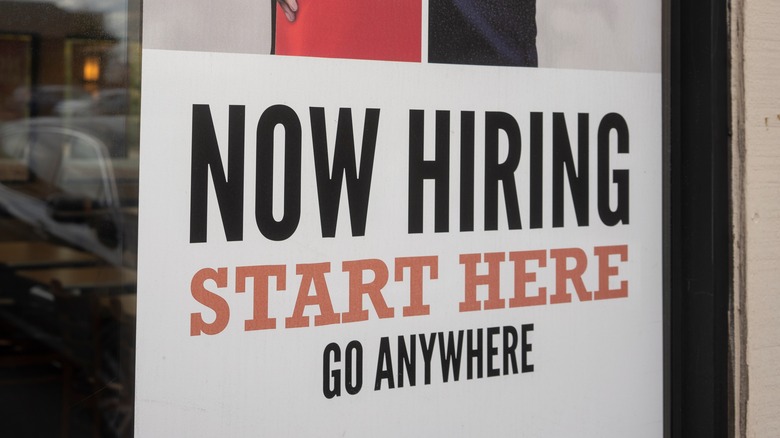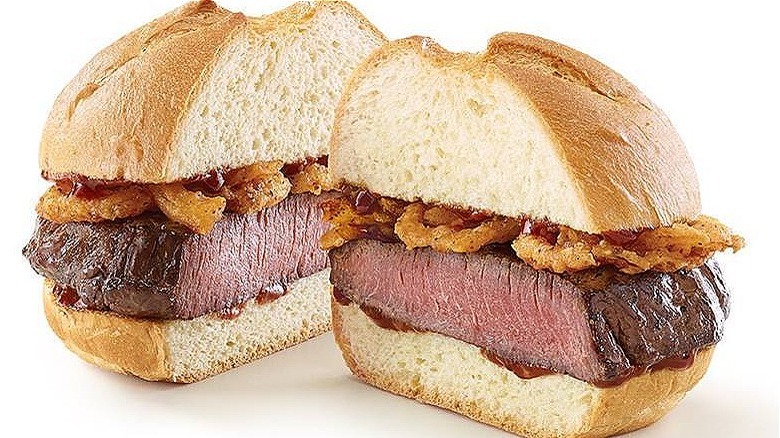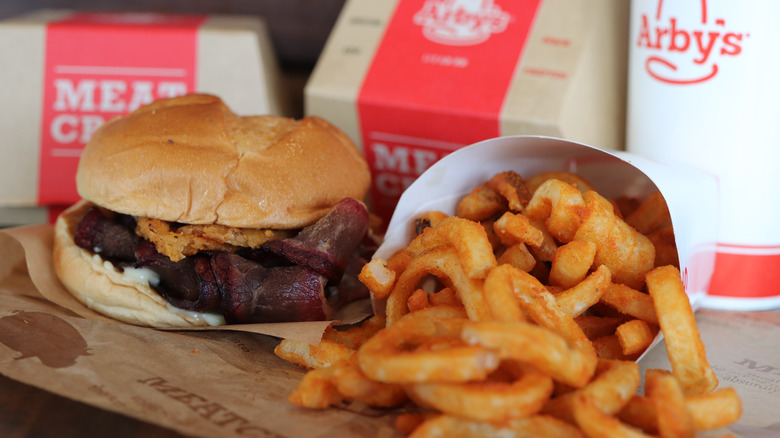We Finally Know Why Arby's Is So Cheap
At one point, Arby's considered itself a high-brow eatery. Don't believe us? When it first opened in 1964, the meat mega-chain came in swinging with 69-cent sandwiches — a huge jump from the measly 15 cents McDonald's charged at the time (via NBC News). Premium taste still binds the menu, certainly, but lucky for us, it's sold at a much lower price point than when the founders Leroy and Forrest Raffel boldly began their venture.
One thing's for sure — Arby's has all the meats. And grabbing a bite at one of its 3,400-plus restaurants is actually fairly affordable (via ScrapeHero). Whether it's Greek-style gyros, savory Reubens, or even roast beef slathered in cheese sauce, Arby's makes the discounts worth your while. Dollar menu fare might not dominate, like similar drive-thru franchises, but carnivores can still fill up without their wallet taking a hit. A Classic Roast Beef sandwich, for example, starts at just $3.29, depending on the location. A small order of curly fries rings up to around $1.69. Finally, according to Fast Food Menu Prices, you can satisfy your sweet tooth with a large Jamocha Shake for under $3 at some stores.
Eating like kings on a peasant's budget — it's the Arby's way. Even so, how did such staggering bargains come to define this scrappy fast food underdog? Going beyond the scope of mere penny-pinching reveals that business strategy, combined with a little risk, is at the heart of how Arby's slings mountainous meats at low prices.
Most of Arby's food is frozen
Let's be honest here. How many drive-thru chains (besides In-N-Out) have ever touted fresh, hand-crafted food prepared on site? The answer is not a lot. Arby's, first and foremost a fast food enterprise, is certainly no exception. The freezer remains Arby's finest asset in promising cheap, convenient eats on the fly, and it's a given that the majority of its lineup has been frozen and thawed out before ever hitting the fryer.
In the case of curly fries, the chain's obvious giveaway, one individual who used to work at Arby's recounted their experience touring the restaurant and seeing the spuds stashed away in a massive walk-in freezer. As the post recalled, "There are bags and bags of curly fries, already curled and ready for the deep fryer" (via Quora). Although a former manager did confirm that Arby's acquires its meats from farms, an employee on Reddit revealed that the slabs of beef are "sealed in plastic bags" before being thawed, and it's a process that can take multiple days before the flank sizzles away in the oven.
Frozen goods definitely explain Arby's lower price point. Acquiring the ingredients, not to mention the labor, of preparing mozzarella sticks from scratch would be much more costly than stashing them away in the freezer. And it stands to reasons that Arby's probably has a supplier who proffers a decent deal on buying items in bulk.
The meat isn't the best quality
Compared to the thinly sliced cutlets from your neighborhood sandwich shop, spending under $4 for a Classic Roast Beef sandwich is a hard bargain to beat (via Fast Food Menu Prices). The trade-off? You're not exactly paying for quality. Arby's takes shortcuts by using meats pumped full of antibiotics, a practice that maintains the profit-driven nature of factory farming, but doesn't necessarily lead to the freshest grub around.
While the U.S. Food and Drug Administration (FDA) ensures antibiotics remain at safe levels for human consumption, Healthline explains that the high rate farms have medicated livestock has created bacteria that are immune to the treatment, thereby rendering many standard medications ineffective in combating infections. Experts have warned of the terrifying possibilities resulting from the excessive pattern established by farms, and solutions have included demanding restaurants to shift their practices. Arby's, unfortunately, is no role model here. Just last year, a massive study conducted by several major nonprofits gave the chain's meat a failing grade on this front, joining Jack in the Box, Sonic, Burger King, and others in missing the mark (via National Resources Defense Council).
Arby's might claim to have the meats, but those meats are going to be cheap. To pile on fistfuls of beef onto bread for millions of hungry customers, it's inevitable that the quality won't be anything to rave about. With those expectations in mind, enjoying a quick bite on a budget is what Arby's is built for.
Condiments contain inexpensive ingredients
Horsey, Smoky Q, Arby's Sauce — there are so many flavorful condiments to smother your favorite Arby's sandwich in. Employees will even toss in a couple extra packets, just to make sure there's ample sauce for coating each and every meat-filled bite. And it's no trouble — Arby's can afford it because the condiments on their own are quite inexpensive, thanks to the cheap ingredients found from within
As confirmed by Arby's handy ingredient guide, many of the components that make up the chain's sauces are quite basic on the surface. Arby's Sauce, the in-house equivalent to ketchup, contains water, corn syrup, tomato paste, and distilled vinegar. Smoky Q Sauce, the Smoked Brisket sandwich's exclusive topper, consists of the above mix-ins in addition to molasses and garlic powder. Nothing fancy. And if you've ever doubted your ability to recreate Arby's garnishes at home, consider the fact that the Italian Seasoning features garlic along with "spices" and "herbs," the two common features of any household spice rack.
Frankly, no one has to venture far to find any of these products. Assuming you're swinging by the supermarket for groceries, finding mayonnaise and horseradish is more than guaranteed, even if you're not planning to whip up homemade Horsey Sauce. Though when it's this easy to make, why not give it a go? It's cheap enough for the average shopper to make, so by extension, it's a huge score for Arby's.
Less popular offerings get the boot
The ultimate profit-killer for a fast food chain is unpopular menu items. When dishes slump behind in sales, restaurants have no choice but to streamline their offerings. Arby's made this call in 2021 when it officially removed some products — including Pizza Sliders and Potato Cakes — from the menu (per Brand Eating). The reason they got scrapped in the first place was due to being "slower-moving." In other words? People weren't buying them at the rate of other, more popular snacks, and that forced the franchise to slim down the selection.
As Inspire Brands' former Chief Financial Officer, David Pipes, once told Forbes "If it doesn't fit our brand positioning, it's easy to rule it out." When it comes to curating a financially successful menu, this philosophy is relevant. Arby's clearly enjoys variety. Just look at the array of meats, cheeses, and starch-centric finger foods that are plastered all over the drive-thru. However, if specific items aren't selling well — or at a pace that satisfies corporate's expectations — then customers can expect to find cuts on occasion.
Sadly, this tactic isn't ruled out when customers allegedly adore the axed item. For example, plenty of fans were gutted by Arby's decision to discontinue the potato cakes and went to great lengths in expressing their frustration. "Guess I'm never eating at Arby's again," one Reddit commenter wrote. Another vowed that "if they don't return, my days as a customer are truly numbered" (via Reddit).
Arby's offers loads of discounts
Arby's might have been considered upscale when it first hit the scene, but times have changed. The chain comes in swinging with hefty discounts, to the point where low markdowns are simply a feature of dining at the western-themed meat peddler. Just signing up for the chain's reward program gives you a free — yes, free — Classic Roast Beef sandwich when you make your first purchase (via Arby's).
In May 2022, Arby's launched a two for $6 promotion, which Thrillist reports featured three items customers could choose from — Classic Roast Beef, White Cheddar Mac 'n Cheese, and the Chicken Cheddar Ranch Sandwich. A month later, per Eat This, Not That, select sandwiches were marked down to half off with any regular menu order. The most current promotion is the "2 for $7 Everyday Value Menu," similar to some extent to the former deal, except with different options. Some specials, such as the "5 for $10" deal on roast beef sandwiches, don't even need a coupon (via Facebook).
As tempting as it is to score massive meat sandwiches on a dime, the deal isn't just for the customer. The franchise also wins too, since more people are likely to visit the restaurant when there's a deal going on, and thus spend more money on more food. Assuming that generosity pays off, Arby's can still remain affordable since it is raking in enough dough to support the (usually temporary) price cut.
Restaurants have reduced their carbon footprint
Even if Arby's food is cheap, the expenses that come with running a restaurant are not. Paying rent, heating and cooling the building, and using energy across a multitude of kitchen appliances is bound to gobble up a pretty penny. In order to keep costs down, Arby's goes the rational route by simply using less energy in its stores, and this has produced big dividends for the company (via QSR Magazine).
A 2015 press statement by the Environmental Protection Agency program Energy Star gave a shout out to the chain's sustainability efforts, which resulted in a 15% drop in energy that same year. How did Arby's do it? By simply tweaking existing protocol, combined with some much needed industrial upgrades. Per Fast Casual, the chain switched over to energy-efficient fryers, refrigerators, and freezers, as well as effective heating, air-conditioning, and a water-saving irrigation system. Frank Inoa, who served as Arby's senior director of engineering, provided QSR Magazine with a few examples of how quick fixes, often at a store level, could cut unnecessary spending. Air escaping the walk-in refrigerator? Attach plastic curtains to prevent cold air from rushing out. Slow day at the restaurant? Cut down on power by unplugging appliances that don't need to be used.
Arby's relies on utilities to function, but it's irresponsible, both environmentally and financially, to burn through energy willy-nilly. And when you have over 3,000 locations operating simultaneously, any solution to save a few bucks is worth it.
Improving the restaurant experience is a cost-effective strategy
Arby's food is served in clean, well-lit quarters across thousands of locations in America. That's by design. Over time, the chain happily renovated its stores to reflect a modern dining experience, whose success Manager of Business Intelligence and Analytics, Karl Riddett, credits to something simple — cold hard statistics. Speaking on the company's use of the logistics platform Tableau, Riddett says "the data showed that we need to spend more money remodeling our restaurants, freshening up the look. That it really has helped the business."
Whether it's replacing furniture, updating point-of-sale software, or spiffing up the menu board, improving a chain's look carries plenty of advantages. One such example? Increased foot traffic. Per Tableau, Karl Riddett discovered visitors trekked in high numbers to revamped locations, as the pause in operations created heightened anticipation around its opening, all the while boosting business to restaurants in the vicinity. Meanwhile, former Chief Financial Officer, David Pipes, added that overhauling physical locations has produced major gains for the company, with customers and franchise owners largely satisfied with the outcome (per Forbes).
Getting people through the doors is how a fast food chain makes money. By utilizing this business strategy, Arby's proves that revamping physical locations is not counterintuitive to saving money. If anything, it's an investment on future returns for Arby's, and by extension, the unbelievable value found on its menu.
Digital ordering saves money
While there's plenty of perks to having a cashier take your order, fast food giants are opting for savvier methods to conduct business. Things have gone digital at Arby's, and that's due to mobile ordering. Using either the chain's website or mobile app customers can, with the click of a button, select their favorite sandwiches, sides, and drinks for pickup or through their takeout app of choice (per Arby's).
Investing in new technology can sometimes be a costly undertaking. However, providing multiple ordering platforms is a safe bet to encourage more customers to visit Arby's, and as David Pipes explained in 2018, the company's gone through the calculations to ensure that the move is still profitable. "When guests are paying by means other than handing their cash or card to the front-line team member – such as via a website or a mobile device – we ensure that all costs are considered and determine what we need for these transactions to be successful," he said to Forbes.
Because the only requirement for mobile ordering is a cell phone and WiFi connection, there's less need for service workers (in other words, a living, breathing person) to accomplish the same task. After all, the customer can do it on the spot, anytime, anywhere. This allows flexibility on the consumer side, while handing Arby's a financial advantage due to cutting out the middleman and effectively outsourcing the labor onto the customer.
Hourly employees don't make a lot of money
Arby's is part of a $30 billion empire under Inspire Brands (via Restaurant Business). But while Arby's has generated mind-blowing profits as of late, the employees responsible for this wealth have largely scraped by on the minimum wage. As Indeed shows, a team member can expect to make $12.40 per hour, while positions with more seniority, like shift leaders, only pull in a little extra at $14.65 an hour. With those numbers, it's no coincidence only 35% of employees reporting on Indeed felt that Arby's compensation was reasonable.
Even under circumstances where Arby's workers were financially stable, issues surrounding work-life balance prevented most employees from feeling content about their jobs. According to a shift manager, the chain barely provided any benefits to the senior hires who were expected to "dedicate their entire lives to the franchise" (via Indeed). Another individual on Simply Hired noted Arby's was prone to limiting hours in a way that made the "decent" wages irrelevant in the face of less work, and therefore meant less money they could earn as a whole.
Arby's is a corporation at the end of the day, and corporations run on the premise that there's money to be made. The ends justify the means, as the saying goes. The cost of your roast beef slider can only stay cheap because the chain is maintaining a low-paid workforce to churn them out in record numbers. Otherwise, prices would look noticeably different.
Novel menu items are offered for a limited time
Roast beef sandwiches, the prime driver of business going back to the Raffel brothers, are far from Arby's only specialty. Chicken salad, hamburgers, smoked ribs, even breaded fish sticks have appeared on the menu. The trick to keeping these items around? Let's just say they don't overstay their welcome. Often, the chain releases products for a limited time, so that fun, out-of-the-box bites can flourish without breaking the bank. Probably the finest example of the scarcity approach was the venison sandwich, which was initially sold in five states back in 2016 before launching nationwide the following year (via Thrillist).
In each roll-out, the product flew out of drive-thru windows almost immediately, and set off polarizing feedback from the public at large (per NPR). Per Forbes, it did exactly as the company intended: "generate a lot of buzz." Other novelty items include a duck sandwich (via Forbes) an elk sandwich (per Eater), and the Diablo Dare Sandwich from January 2022, which famously came equipped with a complimentary shake to recover the tastebuds, according to Inspire Brands. But exclusive products don't have to be quite so out there — just look at the seasonal milkshake flavors rotating throughout the year.
There's no doubt the cost of ingredients and supplies skyrockets when a chain attempts to offer every single dish under the sun. On the flip side, releasing a temporary one-off can mix up the current offerings, all while keeping Arby's budget under control.
Arby's sticks to a humble brand philosophy
There's no denying that Arby's knows who it is and what it does best — big piles of beef between bread. It's nothing flashy or adventurous, but that isn't the point. Arby's brand identity has always been strong and this clear-eyed perception of its image has, without a doubt, helped the company flourish (per Thrillist).
Consider, for example, when Arby's hopped aboard the hamburger bandwagon with the limited-run Wagyu Steakhouse Burger in May 2022 (a company first, per Food & Wine). Arby's could have rolled out dozens of different hamburgers should its debut launch have been a hit, as is the pattern most fast food chains follow. But surprisingly, that isn't what happened. Rather than oversaturate the menu, the restaurant decided in favor of offering a single, albeit better-tasting product. "Instead of focusing on making billions of mediocre burgers," said Chief of Marketing Officer Patrick Schwing, "we're taking a stance on high-quality meat that deserves to be cooked properly" (via CNN).
Besides its soft spot for beef, Arby's menu skews to the lavish side of the drive-thru because of its premium fare, including lofty condiments (horseradish, anyone?) and smoked brisket. A high-end burger, by that token, is completely within the bounds of what the brand has specialized in for decades, all the while remaining enough of a curiosity to draw in new converts under the franchise's wide, welcoming brim, and arguably help Arby's make and save more money in the long run.
